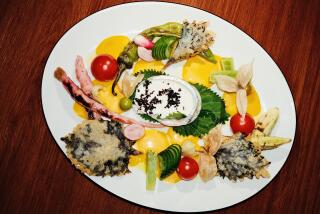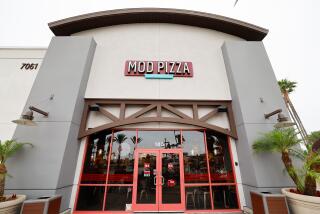Jack in the Box Parent Seeks Acquisition of Irvine Business : Proposal: Taking over Restaurant Enterprises Group would put Foodmaker in direct competition with Taco Bell.
IRVINE â The parent of the Jack in the Box fast-food chain said Thursday that it plans to form a company that would acquire financially troubled Restaurant Enterprises Group Inc. in a $700-million deal.
The transaction would put Foodmaker Inc., based in San Diego, in direct competition with Taco Bell, which said earlier this week that it wants to create the first coast-to-coast chain of sit-down Mexican-style restaurants.
Foodmaker and two major investment firms would set up an operating company to acquire most of Irvine-based REGâs 577 restaurants, which include El Torito, Bobâs Big Boy, Charley Brownâs, Cocoâs and Carrowâs. It would also fold in the Chi-Chiâs Mexican-style restaurant chain, which Foodmaker owns in addition to Jack in the Box.
A majority of REGâs bondholders have approved the proposal, which would return $234.9 million in cash and notes to the investors. They are âvery pleased with the recovery that the agreement would provide,â said a spokesman for REGâs unofficial creditors committee.
Foodmaker, along with investment bank Leonard Green & Partners in Los Angeles and Apollo Advisors in New York, would own the majority interest in the new company. Foodmakerâs chairman, Jack Goodall, would serve as its chairman.
REG and W.R. Grace & Co., which controls privately held REG, have not agreed to the sale. REG and Grace spokesmen on Thursday would not comment on the plan.
REG, under President Norm Habermann, is struggling with remnants of a $737-million debt accrued when a group of former Grace managers took over Graceâs restaurant business in a 1986 leveraged buyout.
The company has paid off more than $380 million of that debt, but in December it stopped making interest payments and opened negotiations with creditors. Forced to return control of REGâs equity to Grace, REGâs managers said then that they would sell a fourth of the companyâs restaurants to raise cash.
The Foodmaker proposal would require REG to file for reorganization under Chapter 11 of the U.S. Bankruptcy Code, said Chuck Duddles, the companyâs chief financial officer. He described the deal as a âprepackaged bankruptcy proceeding . . . in the best interest of REG, its security holders and trade creditors.â
While Habermann has maintained that REG could restructure its debt outside of bankruptcy court, a Chapter 11 filing might be REGâs only option, said Lloyd Greif, president of investment bank Greif & Co. in Los Angeles.
âThe only prayer (REG has) of righting their ship is to clean it up through bankruptcy,â Greif said. âYouâd like to avoid bankruptcy, but frankly, it makes a lot of sense to do this prepackaged deal.â
Janet Lowder, a restaurant consultant based in Rancho Palos Verdes, said the deal âcould be a good alternativeâ for REGâs restaurant chains because the company would not be forced to sell off divisions. âIt would allow them to return their focus to operations, not the daily debt burden, which has got to be an astounding figure,â she said.
Foodmakerâs Duddles said the new operating company would acquire all of REGâs restaurants except the 100 to 150 that are poorer performers. What would happen to those remaining locations was not clear Thursday.
Analysts said Foodmakerâs plan to sell Chi-Chiâs makes sense because Foodmaker would share in the profits generated by the new operating company. They noted that the deal would expand Foodmakerâs market: The Chi-Chiâs Mexican-style sit-down restaurant chain, based in Louisville, Ky., operates mainly in the East and Midwest, far away from Jack in the Boxâs stronghold in the West. Chi-Chiâs, which has more than 200 locations, generated $444.8 million of Foodmakerâs $1.5 billion in revenue for fiscal 1992.
Foodmaker would exchange its Chi-Chiâs chain for a 33% interest in the new operating company and $270 million in cash, Duddles said.
Observers also speculated Thursday that Foodmakerâs proposal might prompt a bidding war for the REG businesses that are viewed as profitable. âMaybe (Taco Bell President) John Martin will one-up Foodmaker with his own bid,â consultant Lowder said.
Taco Bell, based in Irvine, is one of the nationâs largest fast-food operators, with more than 4,000 locations nationwide and $3.3 billion in annual revenue.
On Tuesday, the company entered the competitive sit-down restaurant business by acquiring Chevys, a chain based in San Francisco.
Martin said he intends to use Chevysâ 37 California locations as a base upon which to build a nationwide chain of 300 restaurants.
Foodmakerâs proposal to combine Chi-Chiâs with El Torito, which has about 175 sit-down Mexican-style eateries, would give the new company nearly 400 locations--the nationâs largest collection, analysts said--and would put it in direct competition with Taco Bellâs new endeavor.
Taco Bell is a subsidiary of soft-drink giant Pepsico Inc.
In Thursdayâs trading on the New York Stock Exchange, Foodmakerâs stock gained 50 cents a share to close at $12. The stock had traded as high as $14 a share earlier in the year but plummeted as low as $7.50 after a food-poisoning epidemic that was linked to tainted hamburgers sold by Jack in the Box.
Merger Proposed, Los Angeles Times
Under a $378-million proposal announced Thursday, Restaurant Enterprises Group in Irvine and Foodmaker Inc. in San Diego would merge to form a new company. Restaurants owned by each company:
Restaurant Enterprises Group
Name: Number
Cocoâs: 156
Carrowâs: 126
El Torito: 120
Bobâs, Jojoâs and Allieâs: 76
Casa Galardo: 28
Charley Brownâs: 27
Reubenâs: 20
Other dinner houses: 24
Total: 577Foodmaker Inc. Name: Number
Chi-Chiâs*: 236
* East Coast chain
Source: Los Angeles Times files; Researched by GREG JOHNSON / Los Angeles Times
More to Read
Inside the business of entertainment
The Wide Shot brings you news, analysis and insights on everything from streaming wars to production â and what it all means for the future.
You may occasionally receive promotional content from the Los Angeles Times.







